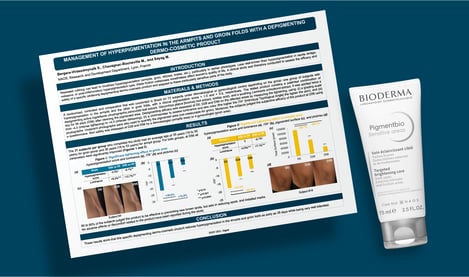7 professionals
The efficacy of a complex of cosmetic active ingredients in melanogenesis, inflammation induced by ultraviolet rays and in brazilian subjects affected by melasma
The efficacy of a complex of cosmetic active ingredients in melanogenesis, inflammation induced by ultraviolet rays and in brazilian subjects affected by melasma
Fauger A.1, Teme B.1,2, Weber S.1, Cadars B.1,2, Chavagnac-Bonneville M.1,2, Graizeau C. 1,2, Trompezinski S.1,2, and Sayag M.1
1NAOS, Research and Development Department, Aix-en-Provence, France
2NAOS Institute of Life Science, Aix-en-Provence, France
Related topics
Melasma, linked to an overactivation of tyrosinase activity, is often characterized by a problematic persistence and recurrence for affected patients, especially because of UV rays, which are responsible for proinflammatory mediators induction, as prostaglandin E2 (PGE2).
To assess the efficacy of an active complex on melanogenesis, UV-induced inflammation, and in melasma.
Melanogenesis was assessed in tubo via tyrosinase activity, and UV-induced inflammation in vitro via PGE2 secretion by keratinocytes treated with the active complex before and after UVA/B irradiation. In the clinical study, 41 Brazilian women (average age 37 years) with mild to moderate melasma applied for 5 months a photoprotector in the morning, and the product with the active complex in the evening. The investigator took standardized photographs, calculated the modified Melasma Area and Severity Index (mMASI) score and assessed overall efficacy and tolerance. The subjects assessed their quality of life (MELASQoL) and subjective efficacy.
The active complex significantly inhibited tyrosinase activity by 81.7% (p<0.001) and PGE2 synthesis up to 74%. In vivo, from 28 days, the mMASI decreased significantly by 15.8% (p<0.001), with an improvement for 58.5% of the subjects, and up to 75.6% at D140, with a decrease in mMASI of 59.6%. The subjects' quality of life was improved at D140 with a significant decrease of 52.0% in MELASQoL. Indeed, they judged the efficacy to be moderate to very significant on lightening, uniformity, prevention of new spots appearance and reduction of spots intensity and size in 63.4% to 78.0% of the cases , and moderate to very high overall efficacy in 90.2%. The product was well tolerated for 78.2% of the subjects.
By inhibiting tyrosinase activity and PGE2 UV-induced inflammation, the active complex reduces the melasma severity from 28 days after application, and thus improves the subjects’ quality of life.
Fauger A.1, Teme B.1,2, Weber S.1, Cadars B.1,2, Chavagnac-Bonneville M.1,2, Graizeau C. 1,2, Trompezinski S.1,2, and Sayag M.1
1NAOS, Research and Development Department, Aix-en-Provence, France
2NAOS Institute of Life Science, Aix-en-Provence, France
Fauger A.1, Teme B.2, Weber S.2, Cadars B.1, Chavagnac-Bonneville M.1, Trompezinski S.2, and Sayag M.1
1NAOS, Research and Development Department, Lyon, France
2NAOS, Research and Development Department, Aix-en-Provence, France


Management of hyperpigmentation in the armpits and groin folds with a depigmenting dermo-cosmetic product
Create easily your professional account
I create my accountGet access to exclusive dermatological services to increase your professionnal knowledge: +500 pathology visuals, clinical cases, expert videos
Benefit from valuable features: audio listening, materials to be shared with your patients
Stay informed about the upcoming events and webinars, latest scientific publications and product innovations